Multiple franchises have been quick to prove that long-delayed sequels are hardly ever worth the wait, and this ranges across all genres. Twelve years after DIE HARD WITH A VENGEANCE came a bored, bald, tired, and profanity-free John McClane in the anemic LIVE FREE OR DIE HARD. Seventeen years between DIRTY DANCING and DIRTY DANCING: HAVANA NIGHTS proved that studios could reuse a film’s title, but they couldn’t make ’80s-era zeitgeist relevant in 2004. Even the horror genre, where sequels are king, and thus have more opportunities to create a worthy follow-up, often shit the bed. Just ask THE RAGE: CARRIE 2 (and don’t even mention PHANTASM: RAVAGER in front of me).
This year’s HALLOWEEN isn’t technically a forty-years-later sequel, considering the franchise has remained active since the 1978 original, but it does embark on the ballsy move of pushing aside alllll those other sequels and remakes and pretending they never happened (something many fans already do) in favor of branching off from the best and least complicated entry in the franchise. (Easter eggs abound, however, for the sharp-eyed franchise fan — there are nods to every single HALLOWEEN entry, including the much maligned HALLOWEEN: RESURRECTION.) It’s additionally ballsy because 1978’s HALLOWEEN is so beloved — by both critics and fans of the genre and film in general. HALLOWEEN is that rare title that transcends its place in horror — a title that most people would say is simply great, and not just great “for a horror film,” which is like saying that cheeseburger you just scarfed down wasn’t bad “for McDonalds.” (Horror don’t get no respect, I tells ya!) If a director says he’s going to make HALLOWEEN 11, expectations are pegged pretty low from the get-go. At that point, most fans just want a solid slasher. But when a director — scratch that, a filmmaker (yes, there is a difference) — enters the scene and says he wants to make a direct follow-up to a legendary title, expectations are reset. There’s less franchise baggage and mythological mud to wade through, and when said filmmaker doesn’t come from a world of music videos but rather a world where his previous films have been released by the snooty Criterion Collection, that’s a big deal for a slasher series. That’s unprecedented territory.
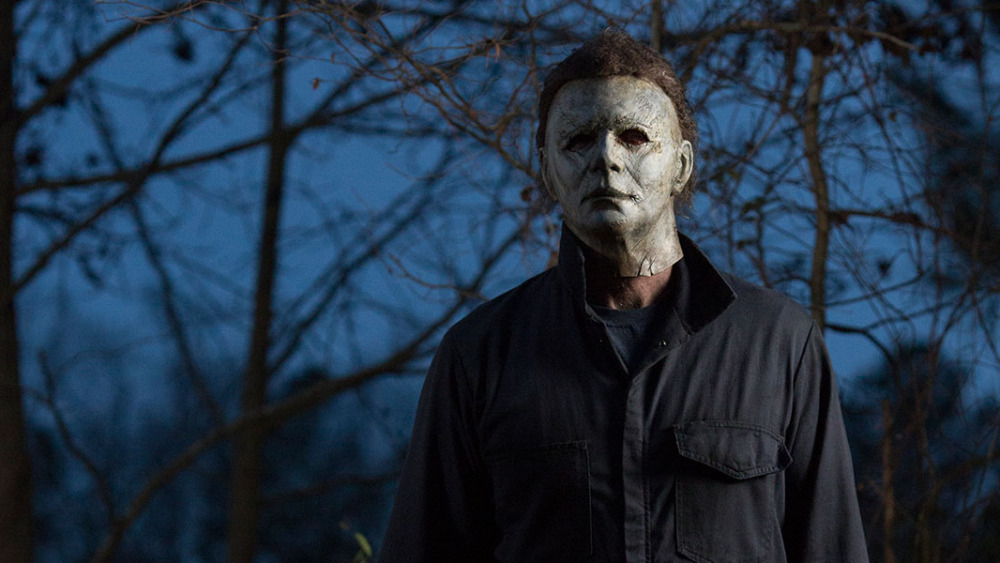
HALLOWEEN ‘18 isn’t as good as the original, but only because that’s an impossible feat — not because the original is a flawless endeavor, but because it became the new watermark upon which all subsequent slasher flicks have been founded. HALLOWEEN didn’t create a handful of the tropes and techniques for which it’s celebrated, but it did perfect them, popularize them, and marry them together in a splendid genre film that was part slasher, part supernatural terror, and part haunted house spookshow fun. HALLOWEEN wasn’t the first slasher film, but it was the first to take the world by storm. John Carpenter’s film endures because it’s pure, well-made in the face of a meager budget, and contains horror’s most iconic masked killer whose creepiness has yet to fade. For a long time, most fans felt that 1998’s HALLOWEEN: H20 was the last respectable entry in the franchise, which saw a returning Jamie Lee Curtis once again doing battle against the boogeyman, who in that timeline was still her brother. Halloween ’18 has now rendered H20 as being near-irrelevant, proving to be the best entry since the original.
In these last forty years, cinema has changed, including the horror and slasher genres. Audiences have different expectations. Charming, near-bloodless thrills just won’t do — not in a film where the bad guy wears a mask and carries a huge knife. HALLOWEEN ‘18 is obviously the bridge that connects the classy and pure intent for terror of the original with modern-day audiences, who expect a certain amount of viciousness and grue in their slasher offerings. Yes, HALLOWEEN ‘18 is violent — perhaps as violent as Rob Zombie’s gritty, immature, and white trashy take on Haddonfield. But (head stomps aside), the violence in HALLOWEEN ‘18 works to its favor, because this isn’t Zombie’s take on Haddonfield — it’s still Carpenter’s, and now Gordon Green’s (and co-writer Danny McBride’s). Their Haddonfield is idyllic, quaint, even boring. In their Haddonfield, murderous rampages aren’t supposed to happen, and it makes those moments — like that gorgeous, unbroken tracking shot which sees Michael walking and slaying from one house to the next — much more shocking. In Zombie’s Haddonfield, where everyone is terrible and exists in a pit of despair, we’re waiting for the violence to unfold. In Gordon Green’s Haddonfield, where the events of 1978 are barely a memory and life seems just fine, we’re hoping the violence never comes, because we’re not sure if we can take it.
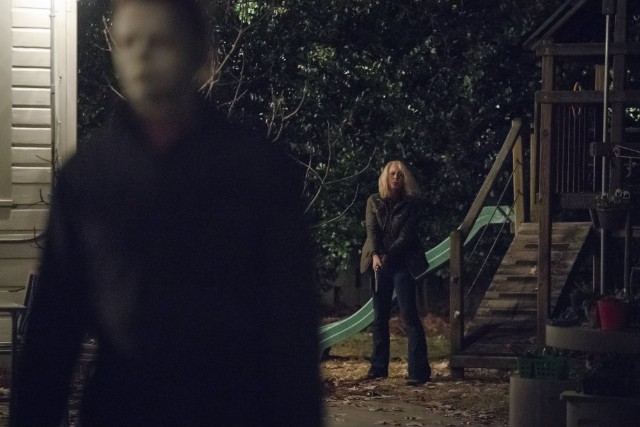
HALLOWEEN ‘18 is being referred to as the series’ #MeToo entry, and while that wasn’t the intention, that’s not wrong, either. It’s one thing to see, and to have become accustomed to, the “final girl” in the slasher genre, but we don’t often get to see that final girl return for another bout of bloody murder committed by her foe, and we certainly don’t see an adult actor return to her teenage stomping grounds as a haunted, ruined shell of a final woman. HALLOWEEN ‘18 is absolutely, positively, without question, Jamie Lee Curtis’ movie — one that honors and acknowledges her legacy in the horror genre, cements just how underrated of a performer she is, and boasts quite possibly her greatest performance in any genre. The Laurie Strode of 2018 is not the Laurie Strode you remember from the original; she’s now a grandmother, baring her scars both physical and emotional from her Halloween encounter forty years prior. She’s the genre’s ultimate defacto heroine, so naturally she’s still strong and tenacious, but only to a degree. It’s not often you see your hero break down in tears throughout his or her journey, and in HALLOWEEN ‘18, you’ll see that more than once. If you’ve invested yourself in Laurie’s struggles over the course of the franchise, and in Curtis’ real-life struggles over the years, your heart will break seeing her steely resolve crumble, leaving her a heaving mess in the arms of her somewhat estranged granddaughter. Judy Greer and a newcoming (and an excellent) Andi Matichak also bring life and complexity to their roles as next-generation Strodes, with the latter naturally drawing the most parallels with circa-1978 Laurie. They’ll prove essential to the inevitable sequel, and it would be to the series’ continued betterment that they return for another round of Halloween carnage.
As for Laurie’s pursuer, Michael Myers, aka The Shape, he’s scary again — not because he’s nine feet tall or cutting off entire heads and throwing them down the stairs, but because Gordon Green utilizes him the way he should be. For the most part, he’s back in the shadows, and he’s also back to playing his cat-and-mouse games — but sometimes he’s captured in blinding, brilliant light, mask or no mask, as a reminder that evil exists all the time, everywhere, and not just in the dark. The aforementioned tracking shot puts you directly at Michael’s back as he walks, unnoticed in his mask on Halloween night, up Haddonfield’s sidewalks, eyeing its people for his next target. You witness his decision-making in real time, and this extremely eerie sequence reinforces what made the original so disturbing: Michael’s murderous motivations weren’t based on him and Laurie being siblings, or because he was being manipulated by an evil Celtic cult, or because there were a bunch of MTV douche bags wandering around his house and only Blackberries and the internet could save them. The original HALLOWEEN was horrifying because Michael’s motives were unknown, and his attacks were utterly random — the horror came from the not-knowing-why. It came from Michael watching Laurie approach the front door of his long-abandoned childhood house as he hid inside its dimness and thinking, “Okay. Her.”
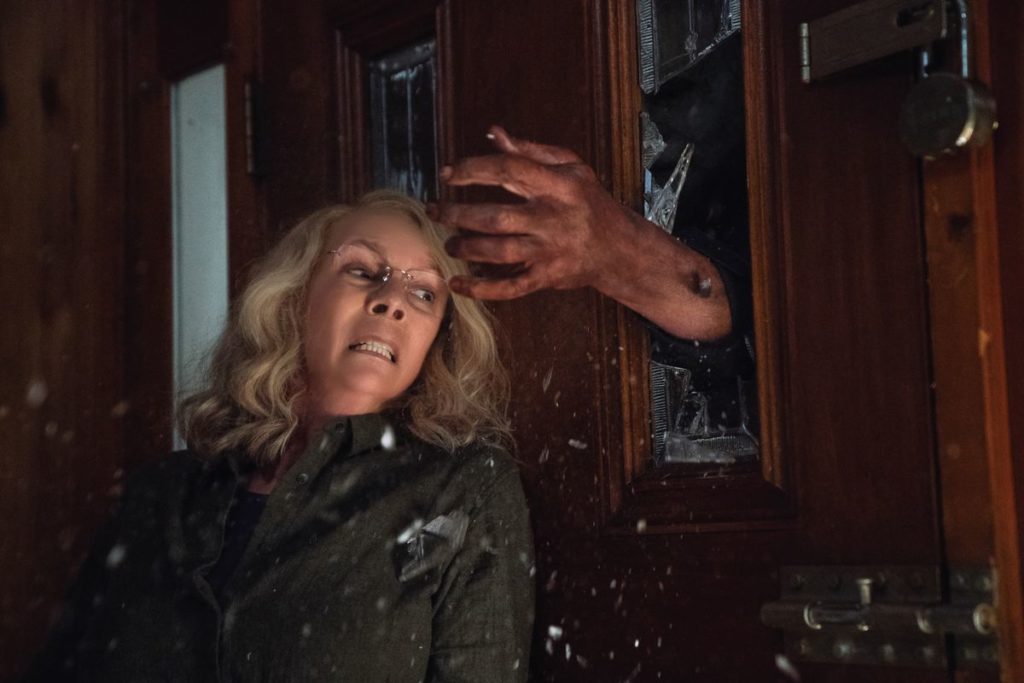
Bolstering Michael’s presence is the phenomenal score — the best since the original and perhaps the best of the franchise — by John Carpenter, Cody Carpenter, and Daniel Davies. It’s a marriage of old themes and new, which perfectly complements HALLOWEEN ‘18, because that’s exactly what the film is, too. Like the original’s film score, the music by itself, without any visual representation of Michael Myers’ mask or knife, is scary. Appropriately, free of its haunting visuals, the score for HALLOWEEN ’18 achieves the same result. Not to mention, Carpenter and sons have pulled off the unthinkable: during the climactic showdown between good and evil, they’ve taken the most recognizable horror theme in cinema history (respect to JAWS) and re-imagined it to be free from fear and tension and re-orchestrated it to sound almost…hopeful. If music has ever made a moment work, it’s this one.
In 2014, Shout! Factory released a comprehensive HALLOWEEN collection that gathered together every entry, as well as every available supplement about the series, along with producing several of their own new retrospectives. The response was ecstatic (and partially undeserved), but they proved one thing: HALLOWEEN fans devour every factoid about their beloved boogeyman whenever possible, and their appetites are voracious. Even Rob Zombie, who made the two most polarizing entries in the series (except maybe for SEASON OF THE WITCH), included a ridiculous three-hour making of documentary on his first HALLOWEEN‘s video release. Universal have seen fit to include a little more on this release than their last several titles, but except for the deleted/extended scenes, the feaurettes run only a few minutes each. To be fair, all aspects of the production are covered, but their combined running time is under 20 minutes. Personally, it’s extremely disappointing that no director/writer/cast commentary track was included, as that would have provided the most background on the film’s production and it feels like a missed opportunity, given the well-established fan love and HALLOWEEN ’18’s ridiculous box office take. (JLC is also hysterical on the commentary track on the 35th Anniversary Edition of the original flick, and more of the same would surely have been guaranteed for this entry.) Physical media is holding its own, but studios (thankfully, for the most part) are getting away from the art of the double-dip, so for now, perhaps until the film’s ten-year anniversary, this will be all she wrote in terms of supplementary material.
Though not without its problems (the Dr. Sartain subplot should have been entirely dropped, as it deviates the main story to a distracting degree), HALLOWEEN ‘18 gets so much right that to laundry-list its faults seems like salty tears. The fact is, a slasher sequel forty years in the making shouldn’t be as good as it is, so instead of dictating faults, let’s instead celebrate that this HALLOWEEN dream-team of David Gordon Green, Danny McBride, Jason Blum, Jamie Lee Curtis, and John Carpenter have achieved the unthinkable: they revitalized one of cinema’s longest-running horror franchises and rebooted not just the property, but the respect it once carried. I’d give anything for this to be the final entry in the series, as it’s doubtful such a sequel could ever live up to what Gordon Green et al. managed to do, but they’ve proven one thing at least: if anyone can do it, they can.
Reprinted with permission from CutPrintFilm.com.
Tags: Andi Matichak, Bill Block, Blu-ray, Cody Carpenter, Daniel Davies, Danny McBride, David Gordon Green, debra hill, halloween, Haluk Bilginer, Horror, jamie lee curtis, Jason Blum, Jeff Fradley, Jefferson Hall, Jibrail Nantambu, john carpenter, Judy Greer, Malek Akkad, Michael Simmonds, Nick Castle, Omar Dorsey, Rhian Rees, Tim Alverson, Toby Huss, Virginia Gardner, Will Patton

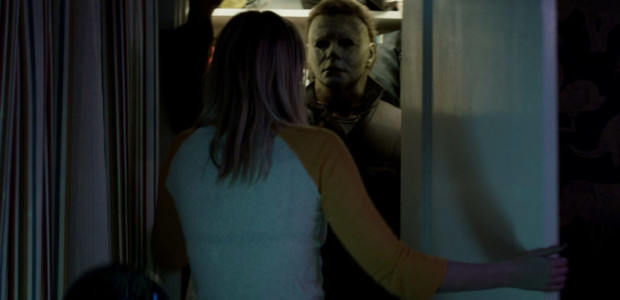
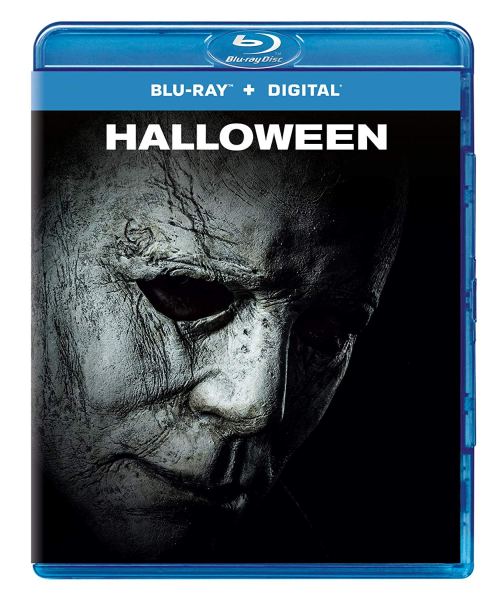
No Comments